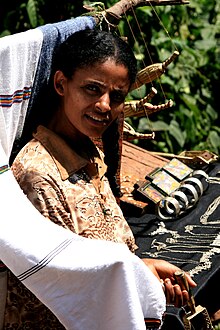 Amhara woman with a Gabi clothing in the background | |
| Regions with significant populations | |
| 19,867,817 (2007)[1] | |
| 248,199[2] | |
| 30,395[3] | |
| 8,620[4] | |
| 4,515[5] | |
| 1,515[6] | |
| Languages | |
| Amharic | |
| Religion | |
| Christianity (Ethiopian Orthodox Tewahedo Church) • Islam (Sunni) • Judaism (Haymanot)[7] | |
| Related ethnic groups | |
| Agaw • Argobba • Beta Israel • Gurage • Tigrayans • Tigrinya • Zay • other Ethiosemitic and Cushitic peoples[8] | |
Amharas (Amharic: አማራ, romanized: Āmara;[9] Ge'ez: ዐምሐራ, romanized: ʾÄməḥära)[10] are a Semitic-speaking ethnic group indigenous to Ethiopia, traditionally inhabiting parts of the northwest Highlands of Ethiopia, particularly inhabiting the Amhara Region. According to the 2007 national census, Amharas numbered 19,867,817 individuals, comprising 26.9% of Ethiopia's population, and they are mostly Oriental Orthodox Christian (members of the Ethiopian Orthodox Tewahedo Church).[1]
They are also found within the Ethiopian expatriate community, particularly in North America.[11][12] They speak Amharic, an Afro-Asiatic language of the Semitic branch which serves as the main and one of the five official languages of Ethiopia.[13] As of 2018, Amharic has over 32 million native speakers and 25 million second language speakers.[14]
The Amhara and neighboring groups in North and Central Ethiopia and Eritrea, more specifically the diaspora refer to themselves as "Habesha" (Abyssinian) people.[15][16][17][18][19]
Historically, the Amhara held significant political position in the Ethiopian Empire. They were the origin of the Solomonic dynasty and all the emperors of Ethiopia were Amhara with the exception of Yohannes IV since the restoration of the dynasty in 1270.[20][21]
- ^ a b Central Statistical Agency, Ethiopia. "Table 2.2 Percentage Distribution of Major Ethnic Groups: 2007" (PDF). Summary and Statistical Report of the 2007 Population and Housing Census Results. United Nations Population Fund. p. 16. Archived from the original (PDF) on 25 March 2009. Retrieved 29 October 2014.
- ^ "Languages spoken in American Households, 2020". United States Census Bureau.
- ^ 2021 Census of Canada. "Statistics Canada 2021". Government of Canada. Retrieved 22 June 2024.
{{cite web}}: CS1 maint: numeric names: authors list (link) - ^ pp, 25 (2015) United Kingdom. Available at: https://www.ethnologue.com/country/GB (Accessed: 30 November 2016).
- ^ Australian Bureau of Statistics 2014, The People of Australia Statistics from the 2011 Census, Cat. no. 2901.0, ABS, 30 November 2016, https://www.border.gov.au/ReportsandPublications/Documents/research/people-australia-2013-statistics.pdf Archived 17 April 2017 at the Wayback Machine.
- ^ "Kieli sukupuolen mukaan maakunnittain ja kunnittain 1990 - 2017". Archived from the original on 26 June 2018. Retrieved 24 January 2019.
- ^ "All Ethiopian Jews must be brought home to Israel". The Jerusalem Post. 18 November 2021. Retrieved 30 May 2022.
- ^ Joireman, Sandra F. (1997). Institutional Change in the Horn of Africa: The Allocation of Property Rights and Implications for Development. Universal-Publishers. p. 1. ISBN 1-58112-000-1.
The Horn of Africa encompasses the countries of Ethiopia, Eritrea, Djibouti and Somalia. These countries share similar peoples, languages, and geographical endowments.
- ^ Following the BGN/PCGN romanization employed for Amharic geographic names in British and American English.
- ^ Zegeye, Abebe (15 October 1994). Ethiopia in Change. British Academic Press. p. 13. ISBN 978-1-85043-644-7.
- ^ United States Census Bureau 2009–2013, Detailed Languages Spoken at Home and Ability to Speak English for the Population 5 Years and Over: 2009–2013, USCB, 30 November 2016, https://www.census.gov/data/tables/2013/demo/2009-2013-lang-tables.html
- ^ Olson, James (1996). The Peoples of Africa. Greenwood Publishing Group. p. 27. ISBN 978-0-313-27918-8.
- ^ Shaban, Abdurahman. "One to five: Ethiopia gets four new federal working languages". Africa News. Archived from the original on 15 December 2020. Retrieved 12 April 2021.
- ^ "Amharic".
- ^ Prunier, Gerard; Ficquet, Eloi (2015). Understanding contemporary Ethiopia. London: Hurst & Company. p. 39. OCLC 810950153.
- ^ Levine, Donald N. (2000). Greater Ethiopia: The Evolution of a Multiethnic Society. University of Chicago Press. ISBN 978-0-226-47561-5. Retrieved 28 December 2016.
- ^ Marvin Lionel Bender (1976). Language in Ethiopia. Oxford University Press. p. 26. ISBN 978-0-19-436102-6.
- ^ Henze, Paul B. (1985). Rebels and Separatists in Ethiopia: Regional Resistance to a Marxist Regime. Rand. p. 8. ISBN 978-0-8330-0696-7.
- ^ Goitom, M. (2017) "Unconventional Canadians": Second-generation "Habesha" Youth and Belonging in Toronto, Canada. Global Social Welfare 4(4), 179–190.
- ^ Gate, Henry Louis; Appiah, Anthony (2005). Africana the encyclopedia of the african and african american experience. Oxford University Press. p. 187. ISBN 978-0-19-517055-9.
- ^ Levine, Donald (1965). Wax & gold : tradition and innovation in Ethiopian culture. p. 2.